Vintage Treasures: The Color Out Of Time by Michael Shea
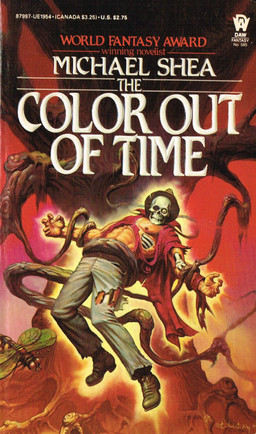 I had a hard time deciding whether a book from 1984 qualified as vintage or not.
I had a hard time deciding whether a book from 1984 qualified as vintage or not.
Then I realized that back in 1984, Ronald Reagan was still in his first term as president. A little checking also showed that the Nr. 1 song in September 1984 was “Missing You” by John Waite and the top film was Ghostbusters.
The final proof that 1984 can be considered vintage is that I was 23 years old back then. So, yeah, I figure that a book from 1984 qualifies as vintage.
So back in 1984, I stumbled across The Color Out of Time at one of our two bookstores in Newark, Ohio. (As added trivia, Newark is the real world counterpart of Gary Braunbeck’s haunted town of Cedar Hill, the fictitious setting for many of his stories). Anyway, this book was especially special back then, as Cthulhu Mythos-themed fiction was scarce. It wasn’t the thriving sub-genre that it is today. So when you found some you grabbed it, paid for it, and then ran like hell to get home and start reading.
Color is one of my favorite Mythos-related books, and it won’t be leaving my collection any time soon. Its rarity on the collectors market shows that those who have it aren’t in any rush to get rid of it. To me, that says a lot about the quality and re-readability of a book.
Michael Shea is one of those rare writers who don’t have a high output, but everything they do produce is of extremely high quality. I’ve been a fan since the 1970s, when I first read A Quest for Simbilis way back in junior high school.
Simbilis is a direct sequel to the late Jack Vance’s Eyes of the Overworld. This is, as far as I know, the only Jack Vance pastiche ever published for mass consumption. Jack Vance gave his blessing to the book even before he wrote his own sequel to Eyes, Cugel’s Saga. That shows a lot of character on Mr. Vance’s part.
Anyway, Simbilis is a great Vancian Dying Earth adventure that, to my eyes, is indistinguishable from the real Jack Vance. It impressed me greatly all those years ago.
The next time I ran across Mr. Shea was in 1982, with his World Fantasy Award-winning novel Nifft the Lean. Nifft is another fine reading experience. Mr. Shea has also authored two of my favourite Lovecraftian horror stories, the Hugo Award nominee “The Autopsy” from 1981 and “Fat Face” from 1987. “Fat Face” has to be one of the most horrible (in a good way) tales that I’ve ever read. It shows that even Shoggoth Lords go courting at times.
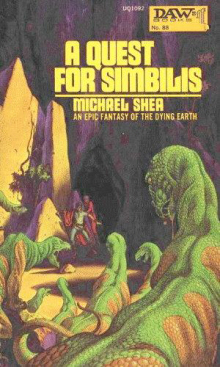 Mr. Shea has won the World Fantasy Award twice and he has also been nominated for the Hugo and Nebula awards. That is exactly how good he is.
Mr. Shea has won the World Fantasy Award twice and he has also been nominated for the Hugo and Nebula awards. That is exactly how good he is.
Now let’s take a look at that book! [Warning — minor spoilers ahead.]
The Color out of Time is a sequel to H. P. Lovecraft’s über-famous story “The Colour Out of Space” from 1927. Lovecraft’s original story deals with the events that take place in a rural Massachusetts valley near the city of Arkham after the impact of an extremely odd meteor. The meteor, after being broken open, leaks a strange liquid metal into the ground and then shortly afterwards inexplicably evaporates, leaving nothing but an impact crater.
A few weeks later, the entire area becomes strangely affected. Plants and animals start to show signs of hyper-vitality, then waste away and turn to dust. Crops grow to extreme proportions of luxuriance, only to be found foul and inedible. The family whose farm the meteor crashed on are also infected by the strange energies released by the meteor. They begin to sicken, mutate, go insane, and eventually die. One son is even dragged into the well by something one night.
The story ends with the strange energy form, which appears to be centered in the family’s well, returning to the sky, bringing the strange occurrences and phenomena to an end.
During this last event, one of the fleeing investigators from Miskatonic University looks back to see something separate itself from the heavenward retreating mass of energy, and fall back to earth to re-enter the well. Nothing grows in the valley after that, and it is finally dammed up and flooded to form a reservoir for nearby Arkham.
The narrator wonders what will be the long-term affects of drinking water that has been tainted by the Colour Out of Space. And yes, HPL spelled it “colour” on purpose.
Of course, the modern reader will think, “Aha! It’s radiation poisoning!” Well, this radiation gives vitality while draining life, spreading corruption, making trees move, and shining in a color that is not part of the normal spectrum. It also seems to be a life form that might just be intelligent, and might even have exhibited a physical manifestation.
A physical manifestation that drags little boys down into wells, that is. You really don’t think HPL would settle for just any old kind of invisible death, do you?
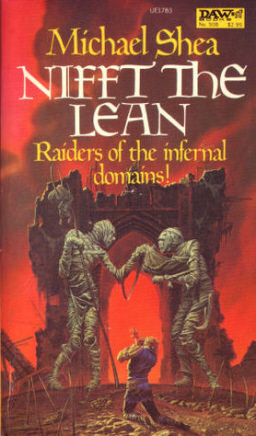 Mr. Shea’s sequel picks up the story over fifty years later. Two academics are taking a boating vacation at a reservoir that’s been converted into a State Park and recreational area. Bothered by the noisy vacationers, our two elderly professors decide to moor their boat in an isolated cove to get away from the hustle and bustle of the crowded docks.
Mr. Shea’s sequel picks up the story over fifty years later. Two academics are taking a boating vacation at a reservoir that’s been converted into a State Park and recreational area. Bothered by the noisy vacationers, our two elderly professors decide to moor their boat in an isolated cove to get away from the hustle and bustle of the crowded docks.
As the sun sets, they realize that the surface of the lake is seething with an unidentifiable oily metallic color. Discussing this strange occurrence, they begin to notice other odd phenomena. The the water has a strange metallic fizz that leaves a foul after-taste, and swimming in it leaves you inexplicably drained of energy.
These guys are 59 and 70, so I’m not at all surprised they’re tired after swimming! But Mr. Shea has another explanation. So we’ll just go along for the ride and enjoy it.
The next day, they take a walk around the entire lake, only to discover the plant and insect life are mutating, growing to freakishly abnormal dimensions. When trying to warn the park rangers, they find both rangers ill and strangely apathetic. It turns out that the state doesn’t think the reservoir supplies decent drinking water for the tourists, so water gets piped in and the two rangers are the only ones drinking directly from the lake.
Creeped out by their visit with the rangers, and the odd noises and stench coming from the upper floor of the rangers’ quarters, our two elderly academics decide to get help, since the two rangers are seriously ill — and one appears to be receiving nightly visitations from something crawling up out of the lake.
You have to understand that Mr. Shea isn’t messing around, since this all takes place in just the first chapter. I’ve read The Color Out of Time four or five times since 1984, and every re-reading is just as enjoyable as the first!
So far, this is some very creepy stuff. Well let me tell you, it gets even better. After snooping around the reservoir’s perimeter some more and determining how far the influence of the Color has spread, the two men take one last boat tour around the reservoir to see if they missed anything, or if things have worsened since their first investigation.
What happens next is possibly the climax of the first third of the book. They are almost hit by a runaway motor boat belonging to some vacationers who are also passing acquaintances. The boat grounds itself at high speed on the shore. Upon boarding it to see if anyone is injured, the two profs discover a scene of destruction and mayhem. The only evidence they can find of the three passengers is large amounts of various body fluids.
I love this logic. The water isn’t good enough to drink on the spot so we’ll just pump it 100 miles away for the flat-landers to drink. Bad idea, guys!
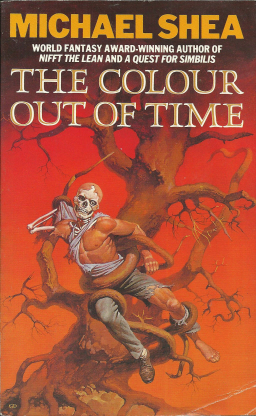 And I mean various! Yuck! Investigating the pilot’s cabin, they discover what’s left of the navigator. I won’t ruin the book for you by describing his condition, but I will tell you that this was one of the goriest death scenes I’ve ever read.
And I mean various! Yuck! Investigating the pilot’s cabin, they discover what’s left of the navigator. I won’t ruin the book for you by describing his condition, but I will tell you that this was one of the goriest death scenes I’ve ever read.
That’s what I love about the book. You get moments of rising dread and suspense, topped off with the occasional — but generous — helping of gore.
They discover that the two rangers have also shrugged off their mortal coils. The older ranger apparently immolated his young colleague alive by pouring diesel fuel on him and then igniting it. He claims, before taking his own life with a .22 calibre slug to the head, that this was a necessary act of mercy. It seems that not only have they been sickened and partially controlled by the lake water, but something vaguely spider-like has been coming from the lake at night and feeding on both of them.
Damn! And this is only the first 50 or so pages. And it gets even better.
I don’t want to ruin your reading experience by giving too much away, so all I’ll tell you is that they soon discover that the Color is gaining strength and widening its area of influence into nearby towns who receive their drinking water from the reservoir. A positive note is that they obtain an ally who informs them that the reservoir stands over the former site of the meteor crash that Lovecraft describes in “The Colour Out of Space.”
It turns out that HPL knew of the events that actually took place in 1927, and wrote a slightly veiled version of the truth, which he disguised as pure fiction. Armed with this new-found knowledge, our trio of dedicated, if somewhat elderly, heroes decide to take the fight to the Color at its source, armed with diving suits, high explosives, and four “Star Stones.”
Just thinking about all this horror and action wears me out. Now, that’s all I’ll give away of the plot. Just do yourself a big favor and find a copy. The effort will be greatly rewarded.
The Color out of Time has so many amazing elements that each one alone could fuel an entire book from a lesser writer.
What I love about the novel:
- A creepy lake/reservoir with a drowned valley, forest, and farmstead beneath its surface;
- A “monster” that has a bodily, chemical, spectral and psychic manifestation. And it doesn’t just take sustenance from its victims’ bodies. It also has the ability to prolong their lives while it’s killing them, so that it can also take nourishment from their mental agony and physical suffering as they die;
- A trio of non-typical protagonists;
- A sense of dread that keeps on building right up to the very end;
- HPL!!!!!!
- Great writing with so much authenticity that you have no trouble suspending your disbelief;
- Gobs of local color (no pun intended) and atmosphere;
- Heroes who fight back! I enjoy the occasional Cthulhu Mythos story where the potential victims don’t accept their fate lying down and decide on making a — sometimes futile — attempt at fighting back. This is one reason that I enjoy Brian Lumley’s Mythos fiction so much.
The only drawback (for me) is one scene where the protagonists learn of the grisly and horribly realistic murders of two small children. Even though they learn of it second hand, I still found it to be fairly upsetting. But aside from this, I found Color to be a book that is extremely suspenseful, scary and exciting.
Now aside from being a top notch horror novel, The Color Out of Time is also one of the most attractively packaged paperbacks that I’ve seen these past 40+ years. The title font is interesting and embossed! You don’t see many embossed covers anymore. The art is simply beautiful. Done by the masterful Ken Kelly, who is most famous for those incredible Robert E. Howard covers he did for Berkley Books back during the middle 1970s, and dozens of covers for the Warren Comics titles Creepy and Eerie from that same period.
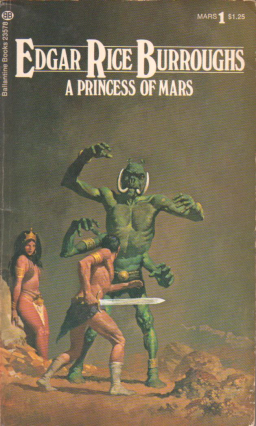 The UK edition from Grafton came out two years later, in 1986. It’s also a lovely edition, if not quite so ambitious in layout.
The UK edition from Grafton came out two years later, in 1986. It’s also a lovely edition, if not quite so ambitious in layout.
What is so bizarre though, is that it seems that it was cheaper to have the cover repainted than to license the original Kelly painting. They simply had another artist copy the DAW cover.
What I find so strange — and a little bit sad — is that they had Gino d’Achille do the new/copied cover. Mr. d’Achille was a master cover illustrator himself. He is the man responsible for all of the beautiful and classy covers for the early 1970s Ballantine Editions of Edgar Rice Burroughs’s Barsoom series.
These were the pre-Michael Whelan John Carter covers that introduced me to ERB during my very early teens.
I find this a bit of a shame. I would have loved to have seen what Mr. d’Achille’s own take on the novel would have been, instead of the copy he was paid to paint.
One thing that does raise the UK editions coolness factor is that the British spelling of “colour” is what HPL intended when he penned “The Colour Out of Space.” I’m surprised that Mr. Shea didn’t title his novel The Colour Out of Time. It could possibly be that his spelling of “color” was an entirely conscious one.
Now before I let you (probably to your relief) go, I just want to end by saying that even if you have to pay a price equivalent to that of a new paperback, it is definitely worth every single penny. I honestly feel the value of The Color Out of Time lies, to the greatest extent, in its story and not in its value as an artifact for collectors who will just bag it in mylar and never bother reading it.
This is honestly a book that screams to be read, and one that greatly deserves a reprint so it can reach a contemporary audience. It’s not just a true treasure for fans of Mr. Lovecraft, but also all horror fans in general.
The Color Out Of Time was published by DAW Books in September 1984. The first UK printing was Grafton Books (1986).
You can find all of our recent Vintage Treasures here.
I love Michael Shea fiercely. In Yana, the Touch of Undying is another favorite; much more in the vein of Nifft. It’s been a while since I read Color; might have to rectify that.
Your mileage may vary, as they say. I love the Nifft books, but when I read Color a couple of years ago, I thought it never made it past the level of competent but rather listless pastiche.
@emcgargle,
I can’t argue with you finding it listless, but it’s not a pastiche.
“Simbilis” is a pastiche since Mr. Shea intentionally wrote in Vance’s style. “Color” on the other hand is written in Mr. Shea’s voice and not HPL’s.
Everythings a matter of taste and when I reread it the other week I enjoyed it as much as I did almost 30 years ago.
take care.
[…] by our traffic stats — Douglas Draa’s Vintage Treasure article on Michael Shea’s The Color Out Of Time, for example, was one of the most popular pieces we published in June (#4 on our Top 50 list), […]
[…] Shea is the World Fantasy Award-winning author of A Quest for Simbilis, The Color Out Of Time, Nifft the Lean, In Yana, The Extra, and the upcoming Assault on Sunrise, among other novels. […]
[…] Mines of Behemoth (Baen, 1997) and the novel The A’rak (Baen, 2000). His other novels include The Color Out Of Time, the sequel to Lovecraft’s 1927 story “The Colour Out of Space;” In Yana, the Touch […]
[…] the Lean (1982) The Color Out Of Time (1984) In Yana, the Touch of Undying (1985) The Mines of Behemoth (1997) The A’rak (2000) […]
[…] the Lean (1982) The Color Out Of Time (1984) In Yana, the Touch of Undying (1985) The Mines of Behemoth (1997) The Extra (2010) […]
[…] the Lean (1982) The Color Out Of Time (1984) In Yana, the Touch of Undying (1985) The Mines of Behemoth (1997) The A’rak (2000) The […]
[…] the Lean (1982) The Color Out Of Time (1984) In Yana, the Touch of Undying (1985) The Mines of Behemoth (1997) The A’rak (2000) The […]
[…] the Lean (1982) The Color Out Of Time (1984) In Yana, the Touch of Undying (1985) The Mines of Behemoth (1997) The Incompleat Nifft […]
[…] the Lean (1982) The Color Out Of Time (1984) In Yana, the Touch of Undying (1985) The Mines of Behemoth (1997) The Incompleat […]
[…] The second thing I’ll mention is that because some of my own fictional excursions overlap with Shea’s foray into Lovecraftian horror — we tread similar unhallowed ground, digging up the bones of past masters of weird horror and coating them with fresh slime, if you will — I find myself contemplating the book not just as a critic but as a writer: appreciating moves he makes while noting missteps and potential pitfalls. Ultimately, Shea’s sequel to H.P. Lovecraft’s 1927 short story “The Colour Out of Space” is entertaining but slightly off, a tad unsatisfying, and I’ll try to pinpoint why — to isolate the juncture at which it diverges from Lovecraft’s vision and to articulate how this impacts the effectiveness of the tale. (For a different take on the book, check out Douglas Draa’s review for Black Gate last year HERE.) […]